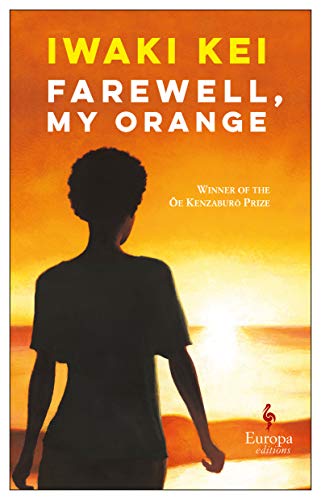Note: This debut novel was WINNER of the Kenzaburo Oe Prize in 2014.
“Often she cried as she showered…as the suds slid smoothly down the slopes of her shoulders in delicate white stripes….Every soap bubble held a sob, which echoed softly against the bathroom ceiling as it burst. Sob after sob resounded there, till at last their accumulated sounds came drifting back down with the pounding water to wrap her body like white feathers. There among the clouds of steam, Salimah’s voice rose to a wail.”
I am espe cially fond of Japanese novels for their quiet power, restraint, and careful structure, and I was looking forward to reading this one, written by a Japanese woman but focusing on characters who have immigrated to Australia, with its totally different culture and completely different language. Iwaki Kei, the Japanese author, knows all about this, having first gone to Australia herself twenty years ago when she was a recent college graduate. She has stayed there with her expatriate Japanese husband ever since, an eventuality which I expected would give much added insight into cultural adaptation, perhaps also including an overlay of analysis into how the differences between cultures affect every aspect of the lives of immigrants. What I found was completely different – surprising, even shocking at first – but which made this, ultimately, one of the most intriguing and original debut novels I have read this year.
cially fond of Japanese novels for their quiet power, restraint, and careful structure, and I was looking forward to reading this one, written by a Japanese woman but focusing on characters who have immigrated to Australia, with its totally different culture and completely different language. Iwaki Kei, the Japanese author, knows all about this, having first gone to Australia herself twenty years ago when she was a recent college graduate. She has stayed there with her expatriate Japanese husband ever since, an eventuality which I expected would give much added insight into cultural adaptation, perhaps also including an overlay of analysis into how the differences between cultures affect every aspect of the lives of immigrants. What I found was completely different – surprising, even shocking at first – but which made this, ultimately, one of the most intriguing and original debut novels I have read this year.

The only job Salimah can get when she first seeks work is as a butcher/ meat packer at a supermarket. She finds it nauseating.
The novel opens with a close-up of Salimah, a woman about thirty, who is escaping the civil war in her Nigerian homeland. She speaks only her Nigerian tribal language, and has no way to communicate with the outside world or to help her two young sons adjust to the differences in their own lives as they start school in Australia. The descriptive opening scene, however, is surprisingly “purple” in its overwritten style, as can be seen in the romantic imagery of the opening quotation of this review. Three pages later, Salimah begins work at a supermarket, butchering and packaging slabs of meat that are “far bigger than herself.” There, as she visits the workplace for the first time and observes the other workers, “Salimah felt a shock like a naked hand clutching her heart….She heard then…a cry that rose from the long row of shadows cast by each of the companions as they worked. These voiceless screams clung to the window sills of the work place, seeking a way out. They beat against the window panes like little trapped birds, hushed but fierce.”
Those who know me know that I have little patience with overly romanticized, sentimental writing, and over-the-top imagery, and, to be honest, I began wondering how the kind of writing here at the beginning of the novel could have led Nobel Prize winner Kenzaburo Oe to personally choose it as the winner of the literary prize named in his honor. Because his own writing, in Nip the Buds, Shoot the Kids, resembles the raw style of William Golding’s Lord of the Flies, I began to suspect (and hope) that as the novel progressed, the reasons for Kei’s writing style here at the beginning would become clearer. As I eventually discovered, the entire novel is made up of stories within stories within stories, and the ways in which misperceptions and misunderstandings can control outcomes, a novel with a built-in surprise at the ending which answers all the questions and makes everything suddenly make sense. Ultimately, the author made me (and I suspect other readers) become involved in her story in new ways – leading me to convey my own version of her story – and my own misperceptions regarding it initially – here in this review.
It is a smart novel, and anyone who starts it and reads it to the end will discover how truly original it really is, and why it is presented exactly as it is.
Shortly after the opening paragraphs, the novel introduces an additional character, whom we know as Sayuri, another young woman who is now living in Australia, except that Sayuri is from Japan, a rare expatriate in Australia. Her husband, an academic, is invited to various places around the world to speak and study, while she has ended her own academic study to follow him to Australia with their baby. She mets Salimah at the ESL course they both are taking, and though Sayuri is much more educated, and much more comfortable in classes, they become friends. Then Sayuri’s life takes an unexpected turn. One confusing and complicating aspect of their relationship is that they both call themselves and each other by different names (also explained by the conclusion of the novel). Salimah is called Nakichi by Sayuri. Sayuri is called Echidna by Salimah. As the two women are absolutely consistent in using these alternative names for each other, the reader easily accepts this odd complication and does not become confused about the women’s backgrounds and the actions they experience within the novel. Their friendship becomes closer when Sayuri (Echidna) makes the surprising decision to work with Salimah (Nakichi) as a butcher and meat packer and not continue working on her thesis for her degree.
The story of Nigerian Salimah continues in chapters written with an omniscient narrator as she labors to improve all aspects of her life and that of her young son. She is earnest and willing to do whatever is necessary to make her family life more successful, and she wins recognition at both her job and at the ESL classes for which she works so hard. Japanese Sayuri reveals herself from a different point of view, through the long, detailed letters she writes to her former college teacher in Japan, letters written in a different, darker typeface. Because the better educated Sayuri has a much broader world view, she may reflect many of the attitudes of the reader, and when she suddenly decides to work as a butcher/meat packer and to learn from Salimah, who has escaped her community in Nigeria for another halfway around the world, it is a poignant moment for Salimah. As both women begin to reach out to others and to develop close friendships that they never expected to make beyond their immediate circles, they become more human, though still grounded in the friendships from the past. Salimah, who has always associated peace, understanding, and love with the orange sun, a repeating symbol here, is ultimately able to say “Farewell, sun. Our meetings at morning and partings at evening will go on. But this is no dream. The sun is the fire that gives me life, eternal desire and prayer, endlessly enduring hope.”
Photos. Salimah, and later Sayuri, both work as butcher/ meat packers at a supermarket when they first arrive in Australia. https://www.shethepeople.tv/
The author’s photo appears on https://www.fantasticfiction.com/
An ESL class, where both main characters work on their English reading, writing and speaking, is shown here: https://www.mosalingua.com/
“Sun Dreams,” like those of Salimah, are found on http://dreamstop.com/



